On The Jeep Grand Cherokee, 2022 Nissan Pathfinder, and More
An inside look at the Detroit Assembly Complex-Mack; a innovative approach to waste-free, two-tone painting; why a forging press is like an F1 car; and other automotive developments.
This week On Automotive
- Major Manufacturing Commitment by Stellantis
- Award for Painting Tech
- F1 & Forging?
- Yes, Even Railroads
- Stylish Italian E-Scooter
- 2022 Nissan Pathfinder: A New Road
///
Major Manufacturing Commitment by Stellantis
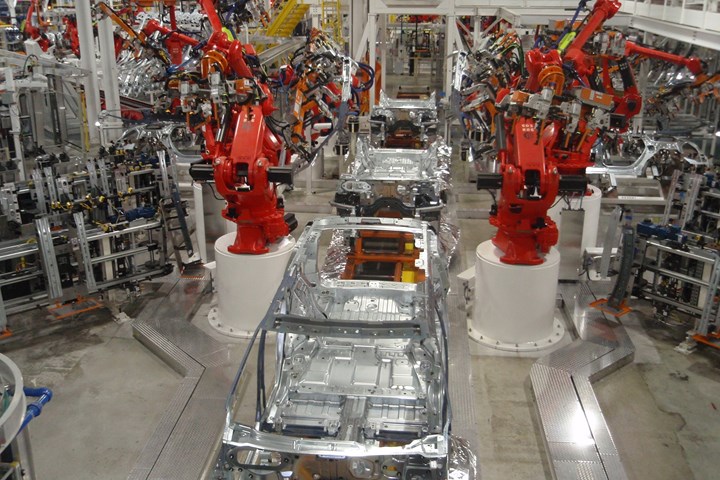
Inside the Detroit Assembly Plant-Mack body shop. There are a total 578 robots in the facility. One of the more interesting cells in the shop is one where radar units are mounted on robot arms that scan the surface of a body during a 45-minute validation test to assure build quality. There is in-line measurement, but this one is used for sampling during all three of the shifts at the plant. (Image: gsv)
The importance of the Grand Cherokee to Jeep cannot be overstated. Even though the previous generation vehicle has been in the market for 10 years, in 2020 there were 209,786 Grand Cherokees sold in the U.S., making it the number-one vehicle in the brand’s lineup. Through May, with 55,198 units moved, it is also the top-seller for Jeep.
So for the 2022 models of the full-size SUV, including the three-row Grand Cherokee L, which is now in production, Stellantis made a $1.6-billion investment in the facility where that production is being performed, the Detroit Assembly Complex-Mack (DAC-M).
Thirty Years! DAC-M is the first new assembly plant in Detroit in 30 years.
The site where it is located had, until December 2019, been where Pentastar engines were manufactured.
There are three major buildings on the property:
- A 650,000-square foot facility that was once the Mack Engine II building (that operation had been idled in 2012) and has been transformed to the Body Shop
- An all-new 800,000-square foot Paint Shop (on the site of parking lot for what was Mack I). The paint shop has five floors.
- A 1,000,000-square foot General Assembly building, which was previously the Mack Engine I plant, where the Pentastars had been built.
Eric Goedtel, senior manager of Plant Facilities Engineering, notes that not only was there an aggressive time schedule to complete the transformation, but that there were some challenges that were the result of turning an engine plant into an assembly plant.
In the body shop, for example, there were trusses that blocked where the conveyors needed to go. They had to cut and reinstall 112 trusses. And there was a need to construct two small buildings on the roof of the body shop for conveyor operation.
Because the paint shop covered a parking lot and because there are some 4,900 people working at DAC-M (three shifts), Stellantis had to buy additional land from the city of Detroit to get parking.
Some Stats:
- There are 578 robots in the body shop. Of those, 26 are used in a net form & piece cell, wherein robots measure vehicle gaps (e.g., hood, liftgate, doors, fenders); the sheet metal is formed to the optimal shape and the metal is pierced for attachment.
- Production time in the body shop is two hours
- In paint—where there are 11 colors available—the process time is 12 hours.
- There are 124 robots in paint.
- The steps in paint are:
- Phosphate e-coat
- Sealer (208 feet per vehicle)
- Primer
- Base coat
- Clear coat
- Finesse and polish
- General assembly involves three macro steps:
- Trim: Sunroof, wiring harness, major electrical, instrument panel, glass installation
- Chassis: Engine dress, engine and chassis marriage, body and chassis decking, hose and electrical connections, fluid fill, functionality testing
- Final: Seat, steering wheel and major component install, doors hung, wheels and tires installed, electrical test, final validation
An Unusual Test Track
One hundred percent of vehicles are put on the buzz, squeak and rattle (BSR) test track. There are various surface conditions on the 2,000-foot track, including pot holes, manhole covers, rumble strips, cobblestone, speed bumps and gravel.
This BSR test takes three minutes to complete.
All of that is pretty standard. This isn’t: The test track is completely enclosed.
Because That May Not Be Enough
Also at DAC-M is what is said to be the first electro-servo shaker of its type in North America. The vehicle is mounted on the device and then the vehicle is, well, shaken. Two minutes, 40 seconds on the shaker is equal to a run on the test track.
When they really want to make sure there are no BSR issues, the Grand Cherokee L can be on the test stand for up to five minutes.
Let’s face it: this is a Jeep with a new architecture.
It is built to take whatever it encounters.
///
Award for Painting Tech
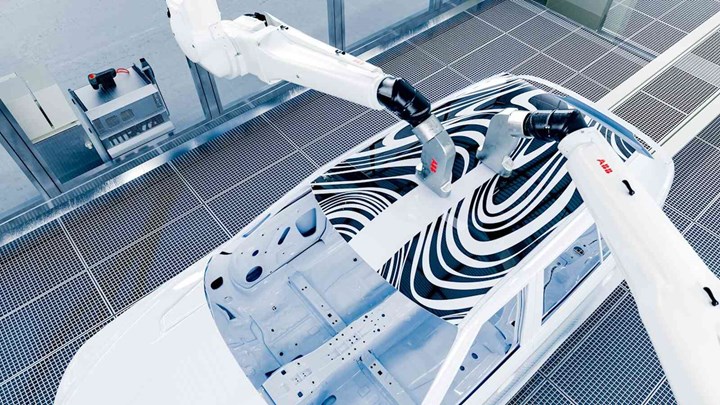
Spraying an elaborate design with no paint waste with PixelPaint. (Image: ABB)
The ABB PixelPaint technology achieved the 2021 “Award for Innovation and Entrepreneurship in Robotics & Automation” (IERA) by the IEEE Robotics and Automation Society and the Industrial Federation of Robotics.
PixelPaint:
- Applies 100% of the paint to the vehicle surface (usually 20 to 30% is waste in the form of overspray)
- Increases throughput by 50% as painting a two-tone vehicle or customized design doesn’t require two passes through the line
- Eliminates masking and demasking operations
Other finalists for the 2021 IERA were:
- InPicker, a universal pick-and-place system from INFAIMON
- MIRAI software, which uses AI to enable robots to deal with production variations, from Micropsi Industries
- MiR250, a mobile robot for material handling from Mobile Industrial Robots
///
F1 & Forging?
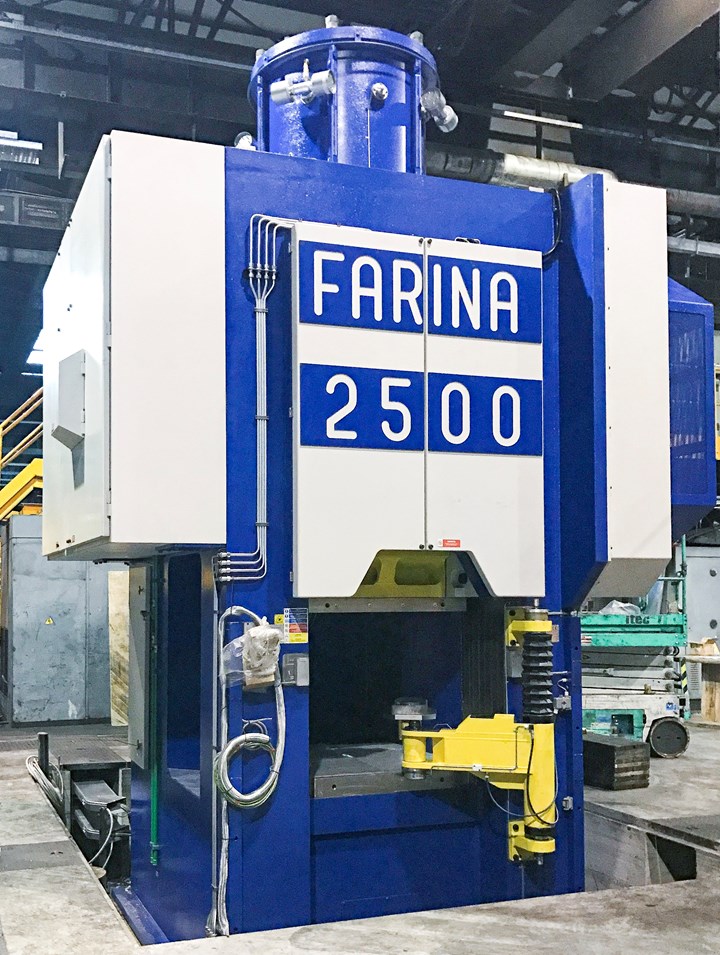
Yes, there is a similarity with F1 cars. Of course, not the styling. (Image: Schuler)
Formula One enthusiasts will know that in the 2009 season KERS—kinetic energy recovery system—was permitted for use by the teams. The system takes energy that would otherwise be wasted during braking and stores it for later use.
Fun fact: The first driver to win an F1 race in a car using KERS was Lewis Hamilton in a McLaren Mercedes at the Hungarian Grand Prix, July 26, 2009.
Of course, that was Lewis Hamilton. . . .
So what does this have to do with forging?
A 2,500-ton hot forging press has been ordered by an Italian supplier, A. Benevenuta & C. S.p.A., which makes parts for suspension systems, transmissions and brakes for passenger vehicles, tractors, trucks and earth-moving machinery.
The press, from Farina, a Schuler affiliate, uses a KERS system.
According to Schuler:
With conventional hot forging presses, a large portion of the energy is converted into heat and dissipates into the environment by the flywheel during the clutch and braking process. With KERS, a switch on the auxiliary drive starts the cycle and takes the strain off the clutch, so that the total energy from the flywheel can be used for the forging process. Similarly, the energy released during the braking process is supplied to the flywheel.
Marco Gritti, Farnia general manager, says that Benevenuta “will not only benefit from 40 percent less power demand, but also from increased output and reduced maintenance costs.”
The press will provide a greater number of strokes per minute: Yes, go faster.
Not F1 faster, but. . .
///
Yes, Even Railroads
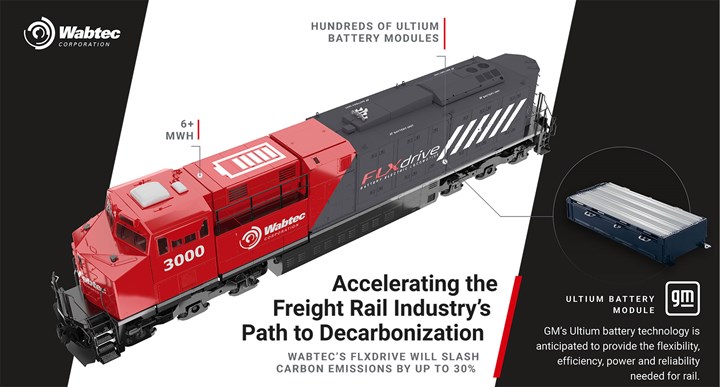
Batteries now, fuel cells coming, for Wabtec. (Image: Wabtec)
Look at that callout near the top center of the above image:
“Hundreds of Ultium battery modules”
And as the image and caption on the right side indicate, those are General Motors battery modules.
Wabtec, which has been in the freight and transit rail industries for some 150 years, is working with GM on not only the implementation of battery cells, but the automaker’s HYDROTEC hydrogen fuel cell power cubes.
Listen:
Rafael Santana, CEO and President of Wabtec:
“Our FLXdrive locomotive, the world’s first 100% battery powered locomotive, has proven its potential to slash carbon emissions by up to 30% when operating at 6 MWh. But we can’t stop there. By working with GM on Ultium battery and HYDROTEC hydrogen fuel cell technologies, we can accelerate the rail industry’s path to decarbonization and pathway to zero-emission locomotives by leveraging these two important propulsion technologies.”
This will certainly help scale both batteries and fuel cells.
///
Stylish Italian E-Scooter

A teaser image of a scooter designed by Pininfarina. (Image: Pininfarina)
While you may—correctly—associate “Pininfarina” with some of the most striking Ferraris ever designed (250 GT Lusso, Testarossa, FF), the Turin-based company, owned by the Mahindra Group of Mumbai, is involved in the design of all manner of transportation.
Including micro-mobility.
As in e-scooters.
Pininfarina is now participating in a micro-mobility service that will initially launch in Italy.
It will do the design.
MT Distribution will do the engineering.
Helbiz will execute the consumer-facing portion of getting the scooters in service.
“Pininfarina, which operates in the most varied areas of design and is a leader in projects designed for environmental sustainability, is particularly sensitive to the new trends in urban mobility.”-- Giuseppe Bonollo, Pininfarina Senior Vice President Sales & Marketing
Yes, more than sports cars.
///
2022 Nissan Pathfinder: A New Road
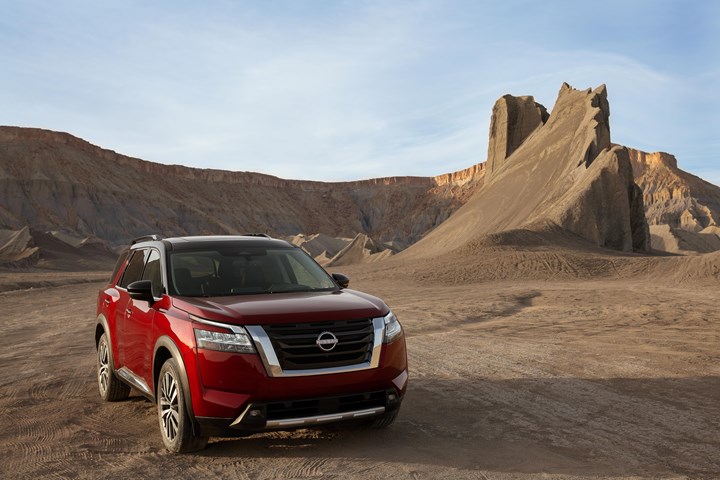
A more competitive vehicle in a highly competitive segment. (Image: Nissan)
The first-generation Pathfinder had its debut back in 1986. It had its run to ’95, with gen two coming in ’96. It lasted to ’04, with gen three going from ’05 to ’12. Gen four was from ’13 to ’20. And now in 2021 the fifth generation, model year 2022, commences.
Notable: Since 2004 the Pathfinder has been built at the Nissan assembly complex in Smyrna, Tennessee.
Notable II: There have been more than 1.8 million Pathfinders sold in the U.S.
Behind the Product Development: Vishnu Jayamohan, senior manager of Product Planning at Nissan, says there were three characteristics that went into the development of the new Pathfinder:
- Rugged
- Flexible
- Connected
Rugged: Looks and mechanicals. The design is inspired by the first generation. Things were far-more trucky back then. The ’22 takes the diagonal C-pillar, bold fender blisters and three slot grille (the three slots are horizontal, adjacent and just below the hood opening).
Compared to its predecessor it is:
- Wider: 77.9 inches (+0.6)
- Higher: 69.7 inches (+0.2)
- Shorter: 197.7 inches (-0.8)
The powertrain setup includes the 284-hp, 259 lb-ft, 3.5-liter V6 as the previous generation (described as being a “proven” engine) and a new nine-speed automatic rather than the CVT that the outgoing model—presumably a benefit regarding towing capability, which is up to 6,000 pounds for both 4WD and 2WD models, a best-in-class level according to Jayamohan (the Ford Explorer comes in second, at 5,600 pounds).
(While on the subject of weight, the ’22 model is some 34 pounds lighter than the previous model; the heaviest in the lineup, the Platinum 4WD, 4,625 pounds. Weight save is achieved by such things as a 50% increase in the use of high-strength steel and new aluminum doors: realize that they have added a number of things to the Pathfinder that add mass, such as more acoustic-attenuating materials, from thicker backing to the carpet to thicker glass.)
Flexible: As in interior space. There is 164.6 cubic feet of total volume in the vehicle, up 10 cubic feet. There is seating for up to eight. This is a three-row vehicle. To get back there they have a pushbutton-activated system, EZ FLEX, that pitches the second-row seat forward on either side. Once in the back, the hip room is 46.7 inches; the previous generation offers 42 inches.
There is a wide array of storage options (including 16 beverage holders). There is, for example, 19.5 liters of total console storage, which is nearly three times more than the previous generation.
With the third row upright, there is 16.6 cubic feet of cargo space. It is 80.5 cubic feet with the second and third rows folded and the width of the rear opening is such that a 4-foot wide piece of plywood can be loaded flat.
Connected: You can tell the level of tech by the real estate given to screens. The Pathfinder has a 9.0 inch touchscreen in the center of the IP. There is a 12.3-inch digital instrument cluster. And a 10.8-inch head up display.
There is “NissanConnect” standard, which includes Apple CarPlay and Android Auto. A Wi-Fi hotspot is available.
ProPILOT Assist with Navi-link is available: it not only provides adaptive cruise control and lane centering, but also can use navigation map data to slow the vehicle for freeway curves or to prepare for a freeway exit.
There is Nissan Safety Shield 360, which includes standard Automatic Emergency Braking with Pedestrian Detection, Blind Spot Warning, Rear Cross Traffic Alert, Lane Departure Warning, High Beam Assist and Rear Automatic Braking, Intelligent Forward Collision Warning, Intelligent Driver Alertness and Rear Door Alert. Blind Spot Intervention, Intelligent Lane Intervention and Traffic Sign Recognition can be added as options.
Subjective: Nissan is evidently working very hard—designing, engineering, producing—on an improvement to its product line. The Pathfinder is certainly a solid example of this work.
The vehicle is sizeable, comfortable, capable and reasonable (i.e., starting MSRP of $33,410 for a Pathfinder S 2WD, going to Platinum 4WD at $48,090).
RELATED CONTENT
-
On Audi's Paint Colors, the Lexus ES 250, and a Lambo Tractor
From pitching a startup idea to BMW to how ZF is developing and using ADAS tech to a review of the Lexus ES 250 AWD to special info about additive at Toyota R&D. And lots in between.
-
On Ford Maverick, Toyota Tundra Hybrid, and GM's Factory Footprint
GM is transforming its approach to the auto market—and its factories. Ford builds a small truck for the urban market. Toyota builds a full-size pickup and uses a hybrid instead of a diesel. And Faurecia thinks that hydrogen is where the industry is going.
-
Apple Reports its First Fender-Bender with Autonomous Car
Apple Inc. reports that one of its self-driving cars operating in autonomous mode was struck by another vehicle while inching into freeway traffic in California.


.jpg;width=70;height=70;mode=crop)






